Seen at Pass'Portes du Soleil
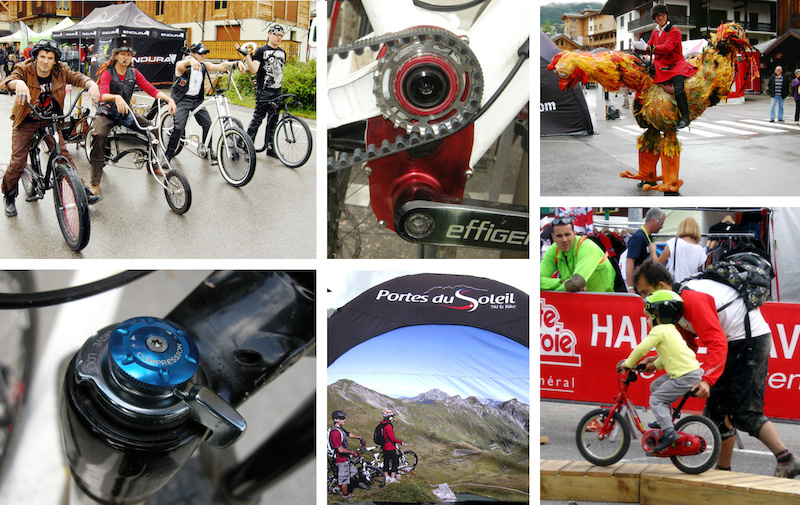
One can never predict the things that will show up at the various stopping points along the Pass'Portes du Soleil.
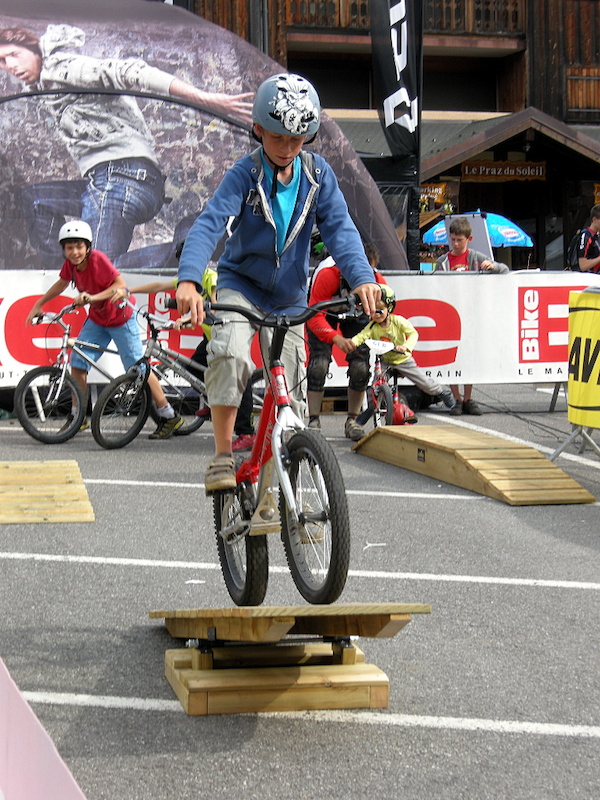
The expo's youth skills course was packed every day.
Welcome to the French Alps
The Pass'Portes du Soleil is the Summer mountain bike version of a popular Winter ski event that is unique to the world, where a number of cities and ski resorts in the corner of France and Switzerland partner together and host an 80 kilometer downhill fest in the Alps that visits 12 towns in two countries. Riders hop from one uplift to another and follow marked routed that lead to the next bike park. After each descent, they arrive at another village, where they are treated to music, food, coffee and beer. If a guided gravity trek through some of Europe's most beautiful Alpine landscapes isn't enough, then you can spice up your ride by choosing any number of trails that lead down to the host cities, including some World Cup downhills. Each year, one of the host towns holds a bike expo, where bike brands and vendors show off their latest and greatest, and offer demo rides. This time, the French city of Les Gets hosted the Expo. The following images are a taste of the event.

Wash, rinse and repeat. Lapierre is a title sponsor and, being a high-profile French brand, always had a line of anxious test riders outside of its tent. Mechanics there were pinned all day long, pressure-washing bikes and setting up suspension for guests. Lapierre's e-bikes were raging.

Two days of sunshine and one day of pissing rain. With over fifty percent of the Pass'Portes du Soleil riders represented by the UK, it was a matter of pride.

Cavalerie Falcon DH bike. The Pass'Portes gives smaller bike makers an opportunity to demonstrate their products a hungry audience. Cavalerie was there with a full lineup of Effigear gearbox bikes. Cavalerie also developed and produces the Effigear transmission. Customers can buy one of Cavalerie's three frame models and then custom select the components on its web store for a custom build.
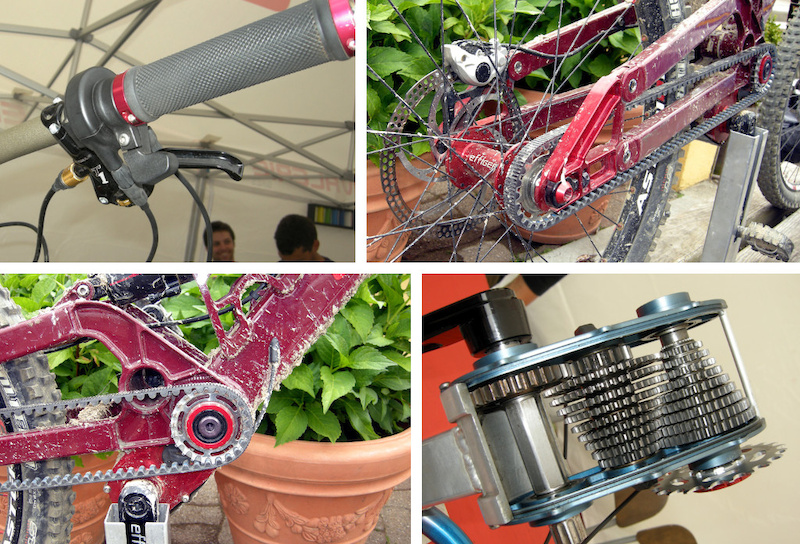
(clockwise) A look at Effigear's Modular rotary shifter. The Gates Carbon Drive cog belt would have been perfect for the Pass'Portes du Soleil, as it rained on and off and riders had to deal with muddy drivetrains. Inside the Effigear nine-speed transmission - the driven gears at the top are fixed to the output shaft, while eight out of the nine lower cogs spin freely on the driveshaft. An an internal shift mech locks one gear at a time to the driveshaft. The reason that there is an overdrive to the transmission is to reduce the torque on the nine pairs of transmission gears so they can be made smaller and lighter weight. The 'bottom bracket' axle fits Isis drive crankarms. Cavalerie's swingarm pivot is concentric to the crank axle, thus the Gates cog belt system can be run without a bash ring or a chain guide
Effigear

Jerome Clementz was cruising the expo while on the mend from his wild crash during round one of the French Enduro Series. Jerome said that he struck a pedal on a concealed rock at full speed and took the impact on his left shoulder. The good news is that the Cannondale enduro champion will be back on the EWS in four weeks.

Intense was busy. With most of its demo fleet in high demand, the rare break in the action was midday, waiting for the fleet to return. Last year, big bikes were the public's first pic, but this year, the favorite was by far, the new Tracer Carbon 275 - although the Carbine 29er was surprisingly popular as well. 'Enduro' was the buzzword in the Les Gets bike park and there was a sea of riders sporting single-crown forks and full-face helmets.
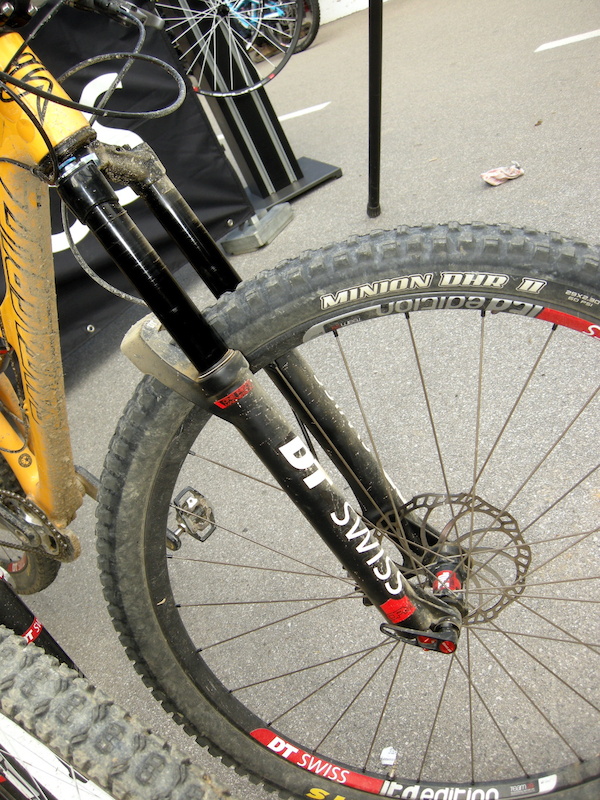
DT Swiss is pushing past its XC-only reputation with the 150-millimeter-travel
XMM fork. Rumors are that they have bigger plans in the works.
DT Swiss had a beautiful 150-millimeter-stroke fork on display. The XMM series has a two-piece hollow reverse arch for added stiffness and sports 32-millimeter stanchion tubes. The lowers are magnesium and the forged aluminum crown has an integrated cable-housing stop for a remote fork lockout device. DT Swiss calls the reversed arch a 'Torsion Box' and it certainly looks like its namesake, with its large and well-defined rectangular profile.
Learning from Manitou and Magura, the reverse arch is a proven boost in torsional stiffness. so we'd expect the same from DT's fork design. The XMM forks shown at the expo used a threaded insert to secure their 15-millimeter through axles. Damping controls included a three-position pedal platform control called 'Twin Shot' that mimics the open, trail and lockout options of Fox and RockShox. An optional remote dial reduces the damping to open and locked. DT Swiss offers the XMM fork in 26, 27.5 and 29 inch format, although only 29 and 27.5-inch models were being shown. Travel options range from 100 to 150 millimeters for the 27.5-inch model, while the 29er fork is limited to 100 or 120 millimeters, with offset options at 41 and 45 millimeters respectively. Weights range from 1510 to 1610 grams, depending upon travel options. North America MSRP: TBD
DT Swiss officials there said that they understand that they will need to up the ante to address the enduro market. The news on the downlow is that DT Swiss is working on a full-fledged enduro fork with a yet to be announced, larger-diameter stanchion tube format. If this is true, expect to see pre-production items as soon as the Eurobike show this Summer.

(Clockwise) DT Swiss calls its rigid reversed arch a Torsion Box. The red Launch Control lockout dial is designed to be cable operated from a remote lever. The lever operated Twin Shot lever features Open, Drive and Lock positions. XMM forks use a well designed 15-millimeter through-axle system.

This rock and roll cover band (left) showed up on customized cruiser bikes, with a boom box blaring 'Born in the USA.' The man on the right had the second largest, um, rooster, that I have ever seen.

Commencal had demo bikes for riders of every size and age. The number of young riders on the mountain was impressive.

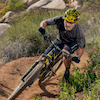
Also my previous post was meant to say "ride THE same trail twice", damn iphone...
But I'll agree, with all those stations linked together, you have plenty of trails to choose from
Rode Les Gets and Supermorzine last year (Morzine's main lift was closed for renovations ... learnt that 1month after I booked the flat like 200m from the lifts ...), enjoyed it even though the weather was completely shiet...
Going back there in 4 days now !
And yeh, its all about licensing fees. without them we could have some incredible forks. hex-lock axle, powerbulge, dual arch, hollow crown, fit inverted charger damping with hot-swappable shim stacks, kashima stanchions and that hard coating rockshox use on their lowers now. i could go on but id have to start flicking through old issues of dirt for inspiration. that fork would be pretty hard to beat...
And do you SERIOUSLY think you would notice the difference??? Jeezusfuk people, get real and get off the computer if its making you this reality ignorant!
In trial motorbikes, as mountainbikes, driving speed and mass involved are lower and insn't necessary such rigidity being way much better that the thick (heavier) part of the fork is down and the thinner part (stanchions) is up, creating a lower gravity center for the best handling possible.
For me it makes sense.
"[Your comment was deleted because] You make a point but can't refrain from adding snipe and derogatory comments. Cheer up. Make your point without being rude."
If you are referring to me when you say uninformed, then you are mistaken. I have experience with every usd design on the market currently and quite a few of the silly older designs that are now discontinued. Shivers probably offered the best damping and bump compliance I have ever experienced. Shame they essentially steered where they thought was best, only paying vague attention to the riders suggestions that it might be nice to stay on the track you are currently riding.
Tracking is following the ground, which includes holding the intended line. Why is this difficult for people to understand. If you want an inverted fork to feel like a conventional fork, you will have to overbuild it, but you will give up the advantage in tracking, which seems backward to me.
"slowing a big motorbike down from high speeds is bloody hard work. a usd fork is better in this regard (among others) and if you build a usd capable of dealing with those loads it will automatically be stiff enough to put up with any torsional stress your puny human arms can dish out. mtbs on the other hand dont suffer anything like the braking forces a motorbike does, so the fork can get away with being far lighter. at the weights achievable, torsional stiffness is reduced to the point that the twisting loads exerted by your mighty limbs start to become quite concerning. conventional forks deal with these forces much better, so if you want a fork at mtb weights that doesnt wander off line when you push it, then with currently available materials this is the way to go."
different sports, different solutions
50+ horsepower through knee deep soil in corners is a hell of a lot more force than we put mtb forks through. Have you ever raced a moto? I think you are making it up as you go.
p.s. if we are going to start questioning each other for making stuff up, I must say I find it somewhat hard to believe you are at least in your late 30's/early 40's, have been racing moto/mtb for over 30 years, and weigh 19 stone. I would imagine your knees would have given up looong ago. no offence meant.
I have owned an XR80 1982, Yz125 1983, XR200RFVC 1984, XR 280 1991 (after college) , CR500 1985, CR250 1997, YZ400fr 1999, KTM 380 1997, KTM 5255SX 2003. You are correct. I beat my body to hell. My right knee is bone on bone right now. I am waiting for a consult with an orthopedic surgeon. I was 220lbs and fit when I was younger.
the issue is MTB forks are easier to deflect in unrealistic circumstances, i.e. holding the wheel and twisting the bar,. The tire cannot EVER get that much traction. Its a myth perpetuated by the manufacturers invested in conventional designs i.e rockshox and fox. RS is changing its tune though, and the writing is on the wall.
Keep posting BS, you are just regurgitating what Fox and RS said to keep you invested in inferior designs. Real world experience doesn't add up to the propoganda.
As for this "MTB forks are easier to deflect in unrealistic circumstances, i.e. holding the wheel and twisting the bar,. The tire cannot EVER get that much traction"
Seriously, whenever I have ridden USD forks they have felt lovely, until i get up to serious speed, at which point they start to feel vague and wandery. Then you slam them into a berm and I physically feel them load up and steer slightly to the outside of the berm, meaning I then need to readjust, or fly out the top of the berm. Not good.
And no fox never told me I felt these things. I did. Stop being so f*cking sure no one actually rides but you....
Where is the inverted prototype that Fox developed some years ago and Gee Atherton raced in one or two BDS events?. Maybe gabriel-mission is the man behind the robbery of Fox's truck wich has inside the aforementioned inverted prototypes so he could be sure that will never see the light. WTF I'm I talking about?. I don't even own a dual crown fork....
Same weight and flex as your boxxer. You can find 20 reviews like this if you look. What was your point again?
www.vitalmtb.com/product/guide/Forks,33/Manitou/Dorado-Expert,11885
Some flex is a good thing. This is one of the best reviews I've read.
As per weight:
Dorado: 2974g
Marz 380: 2750g
Boxxer air: 2689g
Fox air: 2710g.
DVO: 2950g w/o guard, + 300g with.
If you can feel 264g difference, you are superhuman. In a wheel yes, in a fork not a chance.
I mentioned quite early on that inverted feels different at first, but once you learn to ride with one, line holding is much better. It just takes a few rides to get used to the feel. That is what the second reviewer is talking about. People mistake "stiffness" for steering precision/line holding. I don't like the feel of getting deflected off line in a conventional fork.
Following this, I strongly believe that an usd design can be at least equal or superior to a conventionnal one in achieving stiffness and rigidity.
The only drawback is the cost of usd vs. conventionnal given the market price. If the market price is 1800$ for a DH fork, then you have to produce at 400$ in order to maximize your profit. From an economical point, given the market price, if the production price for an usd design is 800$, and only marginal gains in efficiency, what is the interest to produce an inverted fork ?
What is the raw margin on a 40 vs emerald, even at a higher retail price ?
And I think that's why usd will not do a breaktrough.
usd designs will always cost more, since there is no molded parts, instead of conventionnal designs.
And fox is now an equity-fund owned company, so they will not invest over innovation and keep optimizing conventionnal solutions in order to maximise profit.
So the feasibility of an usd design for MTB is not the problem, but the margin of the industry in doing so.
Plus, Cavalerie bikes can be sold with a classic cog for chains.
I'm just curious, what is your current bike uphillsg and which single pivot are you considering instead? I'm guessing you're speaking about a mid travel enduro rig, In which case I can see your point as weight saving is more a priority in relation to suspension performance.
For those that love to be contrary and jump at the neg props, I'm not saying a plain single pivot is a bad design by any means, just less than optimal for a WC level dh rig.